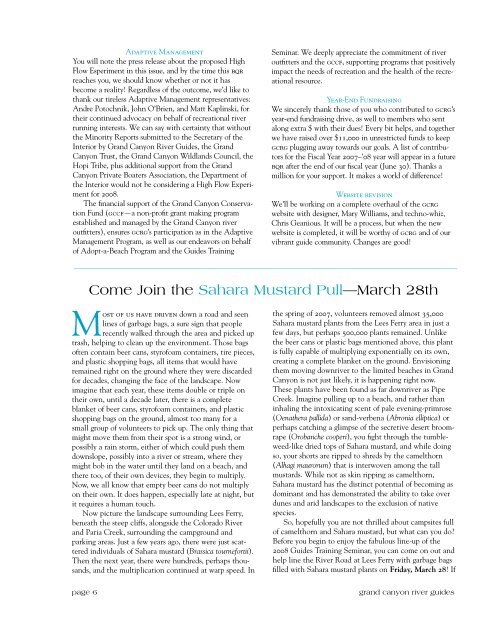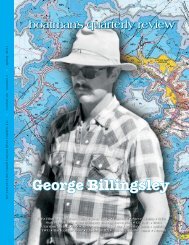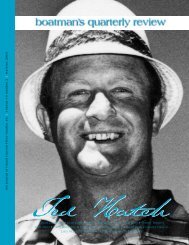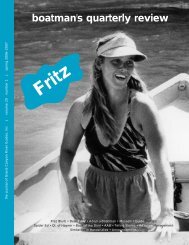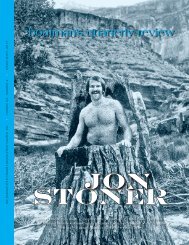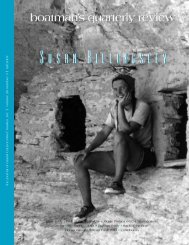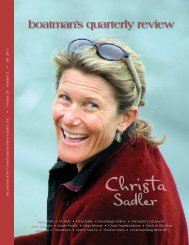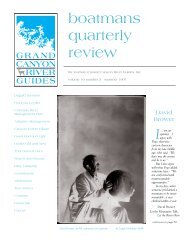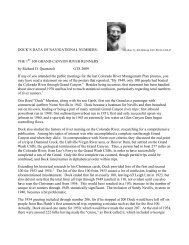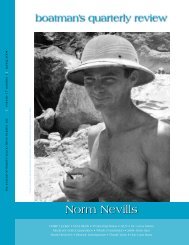boatman's quarterly review - Grand Canyon River Guides
boatman's quarterly review - Grand Canyon River Guides
boatman's quarterly review - Grand Canyon River Guides
You also want an ePaper? Increase the reach of your titles
YUMPU automatically turns print PDFs into web optimized ePapers that Google loves.
Adaptive Management<br />
You will note the press release about the proposed High<br />
Flow Esperiment in this issue, and by the time this bqr<br />
reaches you, we should know whether or not it has<br />
become a reality! Regardless of the outcome, we’d like to<br />
thank our tireless Adaptive Management representatives:<br />
Andre Potochnik, John O’Brien, and Matt Kaplinski, for<br />
their continued advocacy on behalf of recreational river<br />
running interests. We can say with certainty that without<br />
the Minority Reports submitted to the Secretary of the<br />
Interior by <strong>Grand</strong> <strong>Canyon</strong> <strong>River</strong> <strong>Guides</strong>, the <strong>Grand</strong><br />
<strong>Canyon</strong> Trust, the <strong>Grand</strong> <strong>Canyon</strong> Wildlands Council, the<br />
Hopi Tribe, plus additional support from the <strong>Grand</strong><br />
<strong>Canyon</strong> Private Boaters Association, the Department of<br />
the Interior would not be considering a High Flow Experiment<br />
for 2008.<br />
The financial support of the <strong>Grand</strong> <strong>Canyon</strong> Conservation<br />
Fund (gccf—a non-profit grant making program<br />
established and managed by the <strong>Grand</strong> <strong>Canyon</strong> river<br />
outfitters), ensures gcrg’s participation as in the Adaptive<br />
Management Program, as well as our endeavors on behalf<br />
of Adopt-a-Beach Program and the <strong>Guides</strong> Training<br />
Seminar. We deeply appreciate the commitment of river<br />
outfitters and the gccf, supporting programs that positively<br />
impact the needs of recreation and the health of the recreational<br />
resource.<br />
Year-End Fundraising<br />
We sincerely thank those of you who contributed to gcrg’s<br />
year-end fundraising drive, as well to members who sent<br />
along extra $ with their dues! Every bit helps, and together<br />
we have raised over $11,000 in unrestricted funds to keep<br />
gcrg plugging away towards our goals. A list of contributors<br />
for the Fiscal Year 2007–’08 year will appear in a future<br />
bqr after the end of our fiscal year (June 30). Thanks a<br />
million for your support. It makes a world of difference!<br />
Website revision<br />
We’ll be working on a complete overhaul of the gcrg<br />
website with designer, Mary Williams, and techno-whiz,<br />
Chris Geanious. It will be a process, but when the new<br />
website is completed, it will be worthy of gcrg and of our<br />
vibrant guide community. Changes are good!<br />
Come Join the Sahara Mustard Pull—March 28th<br />
Most of us have driven down a road and seen<br />
lines of garbage bags, a sure sign that people<br />
recently walked through the area and picked up<br />
trash, helping to clean up the environment. Those bags<br />
often contain beer cans, styrofoam containers, tire pieces,<br />
and plastic shopping bags, all items that would have<br />
remained right on the ground where they were discarded<br />
for decades, changing the face of the landscape. Now<br />
imagine that each year, these items double or triple on<br />
their own, until a decade later, there is a complete<br />
blanket of beer cans, styrofoam containers, and plastic<br />
shopping bags on the ground, almost too many for a<br />
small group of volunteers to pick up. The only thing that<br />
might move them from their spot is a strong wind, or<br />
possibly a rain storm, either of which could push them<br />
downslope, possibly into a river or stream, where they<br />
might bob in the water until they land on a beach, and<br />
there too, of their own devices, they begin to multiply.<br />
Now, we all know that empty beer cans do not multiply<br />
on their own. It does happen, especially late at night, but<br />
it requires a human touch.<br />
Now picture the landscape surrounding Lees Ferry,<br />
beneath the steep cliffs, alongside the Colorado <strong>River</strong><br />
and Paria Creek, surrounding the campground and<br />
parking areas. Just a few years ago, there were just scattered<br />
individuals of Sahara mustard (Brassica tournefortii).<br />
Then the next year, there were hundreds, perhaps thousands,<br />
and the multiplication continued at warp speed. In<br />
the spring of 2007, volunteers removed almost 35,000<br />
Sahara mustard plants from the Lees Ferry area in just a<br />
few days, but perhaps 500,000 plants remained. Unlike<br />
the beer cans or plastic bags mentioned above, this plant<br />
is fully capable of multiplying exponentially on its own,<br />
creating a complete blanket on the ground. Envisioning<br />
them moving downriver to the limited beaches in <strong>Grand</strong><br />
<strong>Canyon</strong> is not just likely, it is happening right now.<br />
These plants have been found as far downriver as Pipe<br />
Creek. Imagine pulling up to a beach, and rather than<br />
inhaling the intoxicating scent of pale evening-primrose<br />
(Oenathera pallida) or sand-verbena (Abronia elliptica) or<br />
perhaps catching a glimpse of the secretive desert broomrape<br />
(Orobanche cooperi), you fight through the tumbleweed-like<br />
dried tops of Sahara mustard, and while doing<br />
so, your shorts are ripped to shreds by the camelthorn<br />
(Alhagi maurorum) that is interwoven among the tall<br />
mustards. While not as skin ripping as camelthorn,<br />
Sahara mustard has the distinct potential of becoming as<br />
dominant and has demonstrated the ability to take over<br />
dunes and arid landscapes to the exclusion of native<br />
species.<br />
So, hopefully you are not thrilled about campsites full<br />
of camelthorn and Sahara mustard, but what can you do<br />
Before you begin to enjoy the fabulous line-up of the<br />
2008 <strong>Guides</strong> Training Seminar, you can come on out and<br />
help line the <strong>River</strong> Road at Lees Ferry with garbage bags<br />
filled with Sahara mustard plants on Friday, March 28! If<br />
page 6<br />
grand canyon river guides


